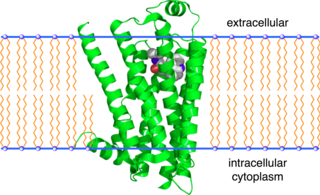A parasympathomimetic drug, sometimes called a cholinomimetic drug or cholinergic receptor stimulating agent, is a substance that stimulates the parasympathetic nervous system (PSNS). These chemicals are also called cholinergic drugs because acetylcholine (ACh) is the neurotransmitter used by the PSNS. Chemicals in this family can act either directly by stimulating the nicotinic or muscarinic receptors, or indirectly by inhibiting cholinesterase, promoting acetylcholine release, or other mechanisms. Common uses of parasympathomimetics include glaucoma, Sjögren syndrome and underactive bladder.

Sympathomimetic drugs are stimulant compounds which mimic the effects of endogenous agonists of the sympathetic nervous system. Examples of sympathomimetic effects include increases in heart rate, force of cardiac contraction, and blood pressure. The primary endogenous agonists of the sympathetic nervous system are the catecholamines, which function as both neurotransmitters and hormones. Sympathomimetic drugs are used to treat cardiac arrest and low blood pressure, or even delay premature labor, among other things.

Beta2-adrenergic agonists, also known as adrenergic β2 receptor agonists, are a class of drugs that act on the β2 adrenergic receptor. Like other β adrenergic agonists, they cause smooth muscle relaxation. β2 adrenergic agonists' effects on smooth muscle cause dilation of bronchial passages, vasodilation in muscle and liver, relaxation of uterine muscle, and release of insulin. They are primarily used to treat asthma and other pulmonary disorders, such as Chronic obstructive pulmonary disease (COPD).

Penbutolol is a medication in the class of beta blockers, used in the treatment of high blood pressure. Penbutolol is able to bind to both beta-1 adrenergic receptors and beta-2 adrenergic receptors, thus making it a non-selective β blocker. Penbutolol is a sympathomimetic drug with properties allowing it to act as a partial agonist at β adrenergic receptors.

Dichloroisoprenaline (DCI), also known as dichloroisoproterenol, was the first beta blocker ever to be developed. It is non-selective for the β1-adrenergic and β2-adrenergic receptors. DCI has low potency and acts as a partial agonist/antagonist at these receptors.
The alpha-2 (α2) adrenergic receptor is a G protein-coupled receptor (GPCR) associated with the Gi heterotrimeric G-protein. It consists of three highly homologous subtypes, including α2A-, α2B-, and α2C-adrenergic. Some species other than humans express a fourth α2D-adrenergic receptor as well. Catecholamines like norepinephrine (noradrenaline) and epinephrine (adrenaline) signal through the α2-adrenergic receptor in the central and peripheral nervous systems.

The beta-2 adrenergic receptor, also known as ADRB2, is a cell membrane-spanning beta-adrenergic receptor that binds epinephrine (adrenaline), a hormone and neurotransmitter whose signaling, via adenylate cyclase stimulation through trimeric Gs proteins, increased cAMP, and downstream L-type calcium channel interaction, mediates physiologic responses such as smooth muscle relaxation and bronchodilation.

Alpha-adrenergic agonists are a class of sympathomimetic agents that selectively stimulates alpha adrenergic receptors. The alpha-adrenergic receptor has two subclasses α1 and α2. Alpha 2 receptors are associated with sympatholytic properties. Alpha-adrenergic agonists have the opposite function of alpha blockers. Alpha adrenoreceptor ligands mimic the action of epinephrine and norepinephrine signaling in the heart, smooth muscle and central nervous system, with norepinephrine being the highest affinity. The activation of α1 stimulates the membrane bound enzyme phospholipase C, and activation of α2 inhibits the enzyme adenylate cyclase. Inactivation of adenylate cyclase in turn leads to the inactivation of the secondary messenger cyclic adenosine monophosphate and induces smooth muscle and blood vessel constriction.

Cirazoline is a full agonist at the α1A adrenergic receptor, a partial agonist at both the α1B and α1D adrenergic receptors, and a nonselective antagonist to the α2 adrenergic receptor. It is believed that this combination of properties could make cirazoline an effective vasoconstricting agent.

An adrenergic antagonist is a drug that inhibits the function of adrenergic receptors. There are five adrenergic receptors, which are divided into two groups. The first group of receptors are the beta (β) adrenergic receptors. There are β1, β2, and β3 receptors. The second group contains the alpha (α) adrenoreceptors. There are only α1 and α2 receptors. Adrenergic receptors are located near the heart, kidneys, lungs, and gastrointestinal tract. There are also α-adreno receptors that are located on vascular smooth muscle.
A sympatholytic drug is a medication that opposes the downstream effects of postganglionic nerve firing in effector organs innervated by the sympathetic nervous system (SNS). They are indicated for various functions; for example, they may be used as antihypertensives. They are also used to treat anxiety, such as generalized anxiety disorder, panic disorder and PTSD. In some cases, such as with Guanfacine, they have also shown to be beneficial in the treatment of ADHD.
Xamoterol is a cardiac stimulant. It works by binding to the β1 adrenergic receptor. It is a 3rd generation adrenergic β receptor partial agonist. It provides cardiac stimulation at rest but it acts as a blocker during exercise.

Befunolol (INN) is a beta blocker with intrinsic sympathomimetic activity used in the management of open-angle glaucoma. It also acts as a β adrenoreceptor partial agonist. Befunolol was introduced in Japan in 1983 by Kakenyaku Kako Co. under the trade name Bentos.

The beta-3 adrenergic receptor (β3-adrenoceptor), also known as ADRB3, is a beta-adrenergic receptor, and also denotes the human gene encoding it.

Denopamine (INN) is a cardiotonic drug which acts as a β1 adrenergic receptor agonist. It is used in the treatment of angina and may also have potential uses in the treatment of congestive heart failure and for clearing pulmonary oedema. It is marketed in Japan under the brand name Kalgut (カルグート) and available as tablets of 5 and 10 mg, and 5% fine granules.

Beta adrenergic agonists or beta agonists are medications that relax muscles of the airways, causing widening of the airways and resulting in easier breathing. They are a class of sympathomimetic agents, each acting upon the beta adrenoceptors. In general, pure beta-adrenergic agonists have the opposite function of beta blockers: beta-adrenoreceptor agonist ligands mimic the actions of both epinephrine- and norepinephrine- signaling, in the heart and lungs, and in smooth muscle tissue; epinephrine expresses the higher affinity. The activation of β1, β2 and β3 activates the enzyme, adenylate cyclase. This, in turn, leads to the activation of the secondary messenger cyclic adenosine monophosphate (cAMP); cAMP then activates protein kinase A (PKA) which phosphorylates target proteins, ultimately inducing smooth muscle relaxation and contraction of the cardiac tissue.
Beta1-adrenergic agonists, also known as Beta1-adrenergic receptor agonists, are a class of drugs that bind selectively to the beta-1 adrenergic receptor. As a result, they act more selectively upon the heart. Beta-adrenoceptors typically bind to norepinephrine release by sympathetic adrenergic nerves and to circulating epinephrine. The effect of B-adrenoceptors is cardiac stimulation, such as increased heart rate, heart contractility, heart conduction velocity and heart relaxation.
Arotinolol is a medication in the class of mixed alpha/beta blockers. It also acts as a β3 receptor agonist. A 1979 publication suggests arotinolol as having first been described in the scientific literature by Sumitomo Chemical as "β-adrenergic blocking, antiarrhythmic compound S-596".

ICI-118,551 is a selective β2 adrenergic receptor (adrenoreceptor) antagonist or beta blocker. ICI binds to the β2 subtype with at least 100 times greater affinity than β1 or β3, the two other known subtypes of the beta adrenoceptor. The compound was developed by Imperial Chemical Industries, which was acquired by AkzoNobel in 2008.

Pardoprunox (INN) is an antiparkinsonian drug developed by Solvay for the treatment of Parkinson's disease that reached phase III clinical trials before being discontinued. It was also being investigated for the treatment of depression and anxiety but these indications appear to have been abandoned as well.













